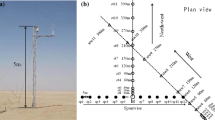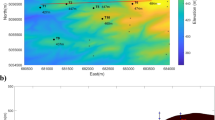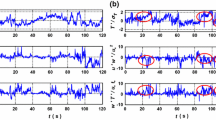Abstract
Space–time correlations are fundamental to statistical theories and turbulence modelling. However, experimental studies of space–time correlations are often restricted to the requirements of high spatially- and temporally-resolved data, especially in the atmospheric surface layer (ASL). In this study, based on the simultaneous multipoint temperature fluctuations measured at different streamwise positions with the application of distributed temperature sensing, the longitudinal space–time correlations of temperature fluctuations (CTT(r, τ)) were directly measured in the near-neutral, unstable, and stable ASL. Our results show that, unlike Taylor’s frozen turbulence hypothesis, the elliptic model can relate the space–time correlation CTT(r, τ) to space correlation (CTT(rE, 0)) in the ASL, where rE = ((r − Ueτ)2 + (Veτ)2)1/2, Ue is the convection velocity, and Ve is the sweeping velocity. Furthermore, we also provide a predictive method for estimating CTT(r, τ) in the ASL based on the elliptic model. With the application of our new method, CTT(r, τ) can be estimated from one-point measurements in the near-neutral, unstable, and stable ASL by using Ue and Ve, and the predicted CTT(r, τ) is similar to the directly measured results. This indicates that our method can be used to reconstruct CTT(r, τ) in the ASL.









Similar content being viewed by others
References
Andreas EL, Claffey KJ, Jordan RE, Fairall CW, Guest PS, Persson POG, Grachev AA (2006) Evaluations of the von Kármán constant in the atmospheric surface layer. J Fluid Mech 559:117–149
Atkinson C, Buchmann NA, Soria J (2015) An experimental investigation of turbulent convection velocities in a turbulent boundary layer. Flow Turbul Combust 94:79–95
Becker MW, Bauer B, Hutchinson A (2013) Measuring artificial recharge with fiber optic distributed temperature sensing. Groundwater 51:670–678
Chauhan K, Hutchins N, Monty J, Marusic I (2013) Structure inclination angles in the convective atmospheric surface layer. Boundary-Layer Meteorol 147:41–50
Chen J, Hu Y, Yu Y, Lü S (2015) Ergodicity test of the eddy-covariance technique. Atmos Chem Phys 15:9929–9944
Cheng Y, Sayde C, Li Q, Basara J, Selker J, Tanner E, Gentine P (2017) Failure of Taylor’s hypothesis in the atmospheric surface layer and its correction for eddy-covariance measurements. Geophys Res Lett 44:4287–4295
Cheng Y, Li Q, Argentini S, Sayde C, Gentine P (2020) A model for turbulence spectra in the equilibrium range of the stable atmospheric boundary layer. J Geophys Res Atmos 125(5)
Del Álamo JC, Jiménez J (2009) Estimation of turbulent convection velocities and corrections to Taylor’s approximation. J Fluid Mech 640:5–26
Favre A, Gaviglio J, Dumas R (1957) Space–time double correlations and spectra in a turbulent boundary layer. J Fluid Mech 2:313–342
Favre A, Gaviglio J, Dumas R (1958) Further space–time correlations of velocity in a turbulent boundary layer. J Fluid Mech 3:344–356
Favre A, Gaviglio J, Dumas R (1967) Structure of velocity space–time correlations in a boundary layer. Phys Fluids 10:138–145
Ghannam K, Poggi D, Porporato A, Katul GG (2015) The spatio-temporal statistical structure and ergodic behaviour of scalar turbulence within a rod canopy. Boundary-Layer Meteorol 157:447–460
Guala M, Metzger M, McKeon B (2011) Interactions within the turbulent boundary layer at high Reynolds number. J Fluid Mech 666:573–604
Han G, Liu L, Bo T, Zheng X (2018) A predictive model for the streamwise velocity in the near-neutral atmospheric surface layer. J Geophys Res Atmos 124:238–251
Han G, Wang G, Zheng X (2019) Applicability of Taylor’s hypothesis for estimating the mean streamwise length scale of large-scale structures in the near-neutral atmospheric surface layer. Boundary-Layer Meteorol 172:215–237
He G, Zhang J (2006) Elliptic model for space–time correlations in turbulent shear flows. Phys Rev E 73(5):055303
He X, Tong P (2011) Kraichnan’s random sweeping hypothesis in homogeneous turbulent convection. Phys Rev E 83(3):037302
He X, Tong P (2014) Space–time correlations in turbulent Rayleigh-Bénard convection. Acta Mech Sinica 30(4):457–467
He X, He G, Tong P (2010) Small-scale turbulent fluctuations beyond Taylor’s frozen-flow hypothesis. Phys Rev E 81(6):065303
He G, Jin G, Yang Y (2017) Space–time correlations and dynamic coupling in turbulent flows. Annu Rev Fluid Mech 49:51–70
Hetsroni G, Tiselj I, Bergant R, Mosyak A, Pogrebnyak E (2004) Convection velocity of temperature fluctuations in a turbulent flume. J Heat Transf 126:843–848
Higgins CW, Froidevaux M, Simeonov V, Vercauteren N, Barry C, Parlange MB (2012) The effect of scale on the applicability of Taylor’s frozen turbulence hypothesis in the atmospheric boundary layer. Boundary-Layer Meteorol 143:379–391
Higgins CW, Katul GG, Froidevaux M, Simeonov V, Parlange MB (2013) Are atmospheric surface layer flows ergodic? Geophys Res Lett 40:3342–3346
Higgins C, Wing M, Kelley J, Sayde C, Burnett J, Holmes H (2018) A high resolution measurement of the morning ABL transition using distributed temperature sensing and an unmanned aircraft system. Environ Fluid Mech 18:683–693
Hutchins N, Chauhan K, Marusic I, Monty J, Klewicki J (2012) Towards reconciling the large-scale structure of turbulent boundary layers in the atmosphere and laboratory. Boundary-Layer Meteorol 145:273–306
Kaimal JC, Finnigan JJ (1994) Atmospheric boundary layer flows: their structure and measurement. Oxford University Press, Oxford
Kaimal JC, Wyngaard J, Izumi Y, Coté O (1972) Spectral characteristics of surface-layer turbulence. Q J R Meteorol Soc 98:563–589
Keller CA, Huwald H, Vollmer MK, Wenger A, Hill M, Parlange MB, Reimann S (2011) Fiber optic distributed temperature sensing for the determination of the nocturnal atmospheric boundary layer height. Atmos Meas Tech 4:143–149
Kim J, Hussain F (1993) Propagation velocity of perturbations in turbulent channel flow. Phys Fluids 5:695–706
Kraichnan RH (1964) Kolmogorov’s hypotheses and Eulerian turbulence theory. Phys Fluids 7:1723–1734
Krogstad P-Å, Kaspersen J, Rimestad S (1998) Convection velocities in a turbulent boundary layer. Phys Fluids 10:949–957
Lenschow DH, Wulfmeyer V, Senff C (2000) Measuring second-through fourth-order moments in noisy data. J Atmos Ocean Technol 17:1330–1347
Li D, Bou-Zeid E (2011) Coherent structures and the dissimilarity of turbulent transport of momentum and scalars in the unstable atmospheric surface layer. Boundary-Layer Meteorol 140:243–262
Liu H, Bo T, Wang G, Zheng X (2014) The analysis of turbulence intensity and Reynolds shear stress in wall-bounded turbulent flows at high Reynolds numbers. Boundary-Layer Meteorol 150:33–47
Liu H, Bo T, Liang Y (2017) The variation of large-scale structure inclination angles in high Reynolds number atmospheric surface layers. Phys Fluids 29:035104
Lotfy ER, Harun Z (2018) Effect of atmospheric boundary layer stability on the inclination angle of turbulence coherent structures. Environ Fluid Mech 18:637–659
Lukassen LJ, Stevens RJ, Meneveau C, Wilczek M (2018) Modeling space–time correlations of velocity fluctuations in wind farms. Wind Energy 21(7):474–487
Mahrt L (2013) Stably stratified atmospheric boundary layers. Annu Rev Fluid Mech 46:23–45
Mahrt L, Thomas C, Prueger J (2009) Space–time structure of mesoscale motions in the stable boundary layer. Q J R Meteorol Soc: A 135:67–75
Marusic I, Heuer WD (2007) Reynolds number invariance of the structure inclination angle in wall turbulence. Phys Rev Lett 99(11):114504
Marusic I, McKeon B, Monkewitz P, Nagib H, Smits A, Sreenivasan K (2010) Wall-bounded turbulent flows at high Reynolds numbers: Recent advances and key issues. Phys Fluids 22:065103
Marusic I, Monty JP, Hultmark M, Smits AJ (2013) On the logarithmic region in wall turbulence. J Fluid Mech 716
Metzger M, McKeon B, Holmes H (2007) The near-neutral atmospheric surface layer: turbulence and non-stationarity. Philos Trans R Soc A 365:859–876
Monin AS, Yaglom AM (2013) Statistical fluid mechanics, volume II: mechanics of turbulence, vol 2. Courier Corporation, Chelmsford
Pope SB (2001) Turbulent flows. IOP Publishing, Bristol
Peltola O, Lapo K, Martinkauppi I, O’Connor E, Thomas CK, Vesala T (2021) Suitability of fibre-optic distributed temperature sensing for revealing mixing processes and higher-order moments at the forest–air interface. Atmos Meas Tech 14:2409–2427
Roy AG, Langer TB, Lamarre H, Kirkbride AD (2004) Size, shape and dynamics of large-scale turbulent flow structures in a gravel-bed river. J Fluid Mech 500:1–27
Stull RB (1988) An introduction to boundary layer meteorology. Springer, Berlin
Sayde C, Thomas CK, Wagner J, Selker J (2015) High-resolution wind speed measurements using actively heated fiber optics. Geophys Res Lett 42:10064–10073
Selker J, Giesen NVD, Westhoff M, Luxemburg W, Parlange MB (2006a) Fiber optics opens window on stream dynamics. Geophys Res Lett 33
Selker J, Thévenaz L, Huwald H, Mallet A, Luxemburg W, van de Giesen N, Stejskal M, Zeman J, Westhoff M, Parlange MB (2006b) Distributed fiber-optic temperature sensing for hydrologic systems. Water Resour Res 42
Simiu E, Potra FA, Nandi TN (2019) Determining longitudinal integral turbulence scales in the near-neutral atmospheric surface layer. Boundary-Layer Meteorol 170:349–355
Talluru K, Pan H, Patterson J, Chauhan K, Flow F (2020) Convection velocity of temperature fluctuations in a natural convection boundary layer. Int J Heat Fluid Flow 84:108590
Taylor GI (1922) Diffusion by continuous movements. Proc Lond Math Soc 2–20(1):196–212
Taylor GI (1938) The spectrum of turbulence. Proc R Soc Lond A 164:476–490
Thomas CK (2011) Variability of sub-canopy flow, temperature, and horizontal advection in moderately complex terrain. Boundary-Layer Meteorol 139:61–81
Thomas CK, Kennedy AM, Selker JS, Moretti A, Schroth MH, Smoot AR, Tufillaro NB, Zeeman MJ (2012) High-resolution fibre-optic temperature sensing: a new tool to study the two-dimensional structure of atmospheric surface-layer flow. Boundary-Layer Meteorol 142:177–192
Wallace JM (2014) Space–time correlations in turbulent flow: a review. Theor Appl Mech Lett 4(2):022003
Wang W, Guan X, Jiang N (2014) TRPIV investigation of space–time correlation in turbulent flows over flat and wavy walls. Acta Mech Sinica 30:468–479
Wills J (1964) On convection velocities in turbulent shear flows. J Fluid Mech 20:417–432
Zhang PJY, Wan ZH, Sun DJ (2019) Space–time correlations of velocity in a Mach 0.9 turbulent round jet. Phys Fluids 31(11):115108
Zhao X, He G (2009) Space–time correlations of fluctuating velocities in turbulent shear flows. Phys Rev E 79(4):046316
Zhou Q, Li CM, Lu ZM, Liu YL (2011) Experimental investigation of longitudinal space–time correlations of the velocity field in turbulent Rayleigh–Bénard convection. J Fluid Mech 683:94–111
Acknowledgements
The field observations were carried out at the Oklahoma State University Range Research Station. The data were provided by Prof. Gentine from the following link: http://www.columbia.edu/~pg2328/Website/MOISST_DTS/dataOnline.rar. We received permission for the use of the data. The author would like to express their sincere appreciation that Prof. Gentine who provided the data to us. This work was supported by National Natural Science Foundation of China (12002141), Tianyou Youth Talent Lift Program of Lanzhou Jiaotong University and Young Scholars Science Foundation of Lanzhou Jiaotong University. The authors would like to express their sincere appreciation for the support as well as the helpful comments from referees that led to a significant improvement in our work. We also thank editor and referees for checking the English grammar and spelling.
Funding
Funding was provided by national natural science foundation of China (12002141)
Author information
Authors and Affiliations
Corresponding author
Additional information
Publisher's Note
Springer Nature remains neutral with regard to jurisdictional claims in published maps and institutional affiliations.
Rights and permissions
About this article
Cite this article
Han, G., Zhang, X. A Predictive Method for Estimating Space–Time Correlations in the Atmospheric Surface Layer. Boundary-Layer Meteorol 184, 423–440 (2022). https://doi.org/10.1007/s10546-022-00711-y
Received:
Accepted:
Published:
Issue Date:
DOI: https://doi.org/10.1007/s10546-022-00711-y




